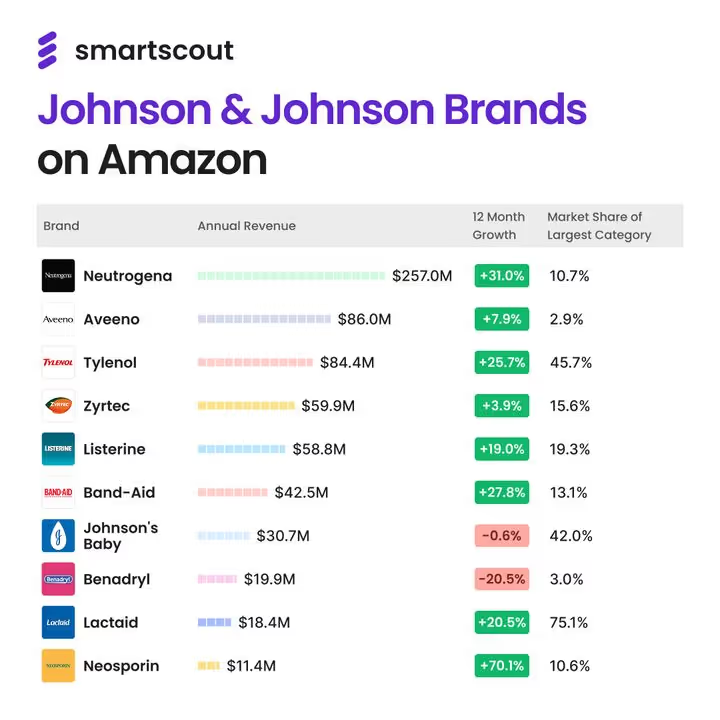Amazon wasn't always a battlefield for consumer packaged goods (CPG)—it was once an afterthought, a secondary channel compared to retail giants.
However, the latest performance data from Johnson & Johnson’s household brands tells a different story. Amazon has transformed into a critical front for omnichannel brands, where even legacy names must fight to keep their positions.
A Snapshot of Johnson & Johnson’s Amazon Empire
From skincare to baby care to medicine cabinet staples, here’s how J&J brands performed on Amazon this past year:
- Neutrogena: $257.0M (+31.0%) | 10.7% market share
- Aveeno: $86.0M (+7.9%) | 2.9% market share
- Tylenol: $84.4M (+25.7%) | 45.7% market share
- Zyrtec: $59.9M (+3.9%) | 15.6% market share
- Listerine: $58.8M (+19.0%) | 19.3% market share
- Band-Aid: $42.5M (+27.8%) | 13.1% market share
- Johnson’s Baby: $30.7M (-0.6%) | 42.0% market share
- Benadryl: $19.9M (-20.5%) | 3.0% market share
- Lactaid: $18.4M (+20.5%) | 75.1% market share
- Neosporin: $11.4M (+70.1%) | 10.6% market share
Key Insights & Notable Performers
Breakout Star: Neosporin (+70.1%)
Neosporin may seem modest at $11.4 million, but with a staggering 70.1% year-over-year growth, it's Amazon’s fastest-rising J&J brand. Neosporin's sharp uptick highlights that targeted positioning, clear consumer needs, and visibility in search results can quickly drive big gains, even for smaller players.
Quiet Dominance: Lactaid (75.1% market share)
Lactaid doesn’t make big headlines, but it quietly dominates its category with a whopping 75.1% market share. Its steady 20.5% growth illustrates how brands win by aligning with specific consumer problems—here, lactose intolerance—and owning the related search intent.
Tylenol and Johnson’s Baby: Big Share, Divergent Paths
Both Tylenol and Johnson’s Baby command over 40% market share in their categories. Yet only Tylenol is thriving (+25.7%). Johnson’s Baby, despite its enormous footprint, is slightly declining (-0.6%), reflecting increasing competitive pressure from newer, digitally-savvy baby-care brands.
Red Flag: Benadryl (-20.5%)
Benadryl’s significant drop (-20.5%) may signal declining relevance, poor Amazon positioning, or shifting consumer preferences toward alternative allergy treatments. Brands must proactively refresh and reposition to avoid this fate.
Lessons for Brand Builders: Why Category Ownership Matters
J&J’s Amazon presence isn’t about dabbling—it’s about dominating. Brands like Neutrogena, Lactaid, and Tylenol prove success comes when companies clearly define, then aggressively own, their categories. Amazon isn’t a place for half-measures; winning means understanding consumer intent, aligning products with clear needs, and leveraging Amazon’s powerful search-driven ecosystem.
Brands that thrive on Amazon don’t just compete—they shape their market. Even smaller brands can punch above their weight if they become synonymous with their category. The Amazon battleground rewards clarity, specificity, and smart positioning above all.
Final Thought:
Amazon’s evolution from an afterthought to a crucial battlefield means brands can't afford complacency. Johnson & Johnson’s experience is a powerful lesson: category dominance isn’t optional—it’s essential.










